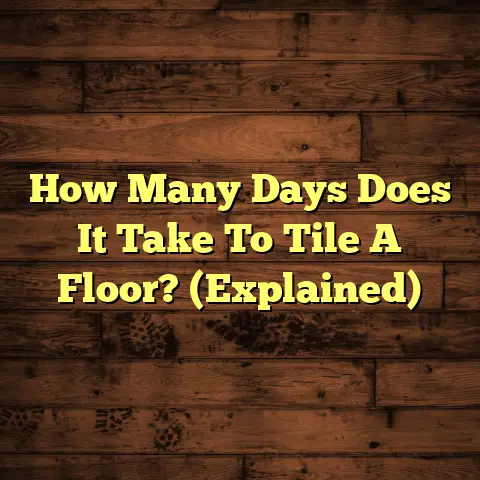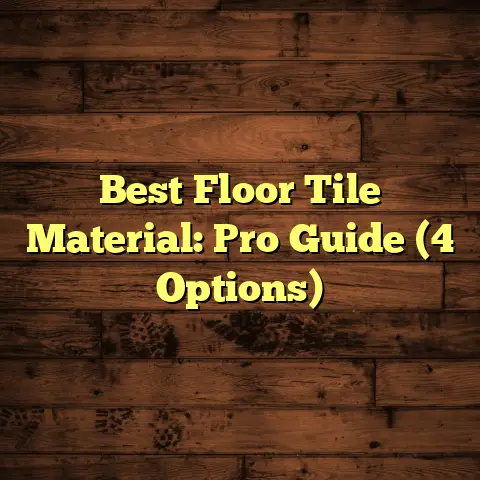Grey Hexagon Mosaic Tile Appeal? (5 Trends Explode!)
But why? What’s so special about these little geometric wonders? Well, let’s dive in and explore the craftsmanship, the color psychology, and the top 5 design trends that are making grey hexagon mosaics a must-have.
Introduction: The Art of the Tiny Tile
Think about mosaic tiles for a second. They’re not just some mass-produced product; they’re a miniature art form. I’ve personally visited workshops where artisans meticulously cut, shape, and arrange each tiny piece.
It’s a skill honed over generations, a dedication to precision that transforms raw materials into stunning surfaces. From selecting the perfect shade of grey to ensuring uniform thickness, every step is crucial.
The process is more than just technical; it’s artistic. These artisans understand color theory, spatial relationships, and the subtle nuances that make a mosaic truly captivating.
Mosaic tiles have a rich history. The Romans and Greeks were masters of the craft, creating intricate scenes that have survived for millennia.
Their geometric patterns, often based on natural forms, create a timeless aesthetic that transcends trends. It’s no wonder that mosaics continue to inspire designers today.
The beauty of mosaics lies in their ability to create complex designs from simple shapes. The hexagon, with its six sides and inherent symmetry, is a particularly versatile choice.
When arranged in a mosaic, hexagons create a sense of order and visual interest, adding depth and texture to any space.
Section 1: The Allure of Grey
Grey. It’s not just a color; it’s a chameleon. It can be sophisticated, calming, edgy, or modern, depending on how you use it.
In the design world, grey has become a staple. It’s the new neutral, offering a more nuanced and versatile alternative to beige or white.
Think about it: grey works in kitchens, bathrooms, living rooms, and even outdoor spaces. It complements a wide range of color palettes, from bright pops of color to muted earth tones.
I’ve found that clients often choose grey because of its calming psychological effects. It’s a color that promotes relaxation and tranquility, making it ideal for creating a serene atmosphere in your home.
Consider these points regarding the psychology of the colour grey:
-
Calming and Neutralizing: Grey is often associated with neutrality, balance, and calmness. It can create a sense of peace and tranquility in a space, making it ideal for areas where relaxation is desired.
-
Sophistication and Elegance: Darker shades of grey, such as charcoal or slate, can convey a sense of sophistication, elegance, and formality. These shades are often used in high-end designs to add a touch of luxury.
-
Subtlety and Restraint: Grey is a subtle color that doesn’t demand attention, making it a good choice for backgrounds and accent walls. It allows other colors and design elements to stand out without being overwhelming.
-
Versatility and Adaptability: Grey is highly versatile and can be paired with a wide range of colors. It works well with both warm and cool tones, making it easy to integrate into various design schemes.
-
Modern and Contemporary: Grey is a popular choice in modern and contemporary designs. It provides a clean, minimalist backdrop that enhances the overall aesthetic.
Here’s a table showcasing different shades of grey and their psychological associations:
| Shade of Grey | Psychological Association | Common Uses |
|---|---|---|
| Light Grey | Calmness, neutrality, peace | Bedrooms, bathrooms, offices |
| Medium Grey | Balance, stability, practicality | Living rooms, kitchens, hallways |
| Dark Grey | Sophistication, elegance, formality | Dining rooms, home theaters, accent walls |
| Charcoal Grey | Strength, power, mystery | Studies, libraries, entertainment areas |
| Silver Grey | Modernity, sleekness, innovation | High-tech spaces, contemporary designs |
Source: Color Psychology in Interior Design
Now, imagine a bathroom with light grey hexagon mosaic tiles on the floor. The soft, muted color creates a spa-like atmosphere, while the geometric pattern adds a touch of visual interest.
Or picture a kitchen backsplash with darker grey hexagon tiles, providing a sophisticated backdrop for stainless steel appliances and natural wood cabinets.
The possibilities are endless!
Section 2: Trend 1 – Modern Minimalism
Minimalism is all about “less is more”. It’s about creating a clean, uncluttered space that promotes a sense of calm and focus.
Clean lines, simple shapes, and a neutral color palette are key elements of minimalist design. And that’s where grey hexagon mosaic tiles come in.
These tiles can contribute to a minimalist aesthetic by adding subtle texture and pattern without overwhelming the space.
I’ve seen minimalist bathrooms where grey hexagon mosaics are used on the floor, extending up the shower wall to create a seamless, spa-like retreat.
The key is to choose a light to medium shade of grey and keep the grout lines thin and consistent. This creates a cohesive look that enhances the overall sense of tranquility.
Texture plays a crucial role in minimalist design. Since the color palette is often limited, texture becomes the primary way to add depth and visual interest.
The geometric shapes of hexagon tiles provide a subtle texture that complements the clean lines and smooth surfaces of minimalist furniture and fixtures.
Here are some tips for incorporating grey hexagon mosaic tiles into a minimalist design:
- Choose a light to medium shade of grey: This will help create a bright and airy space.
- Keep the grout lines thin and consistent: This will create a seamless look.
- Use a matte finish: This will add a subtle texture without being too distracting.
- Pair with simple, clean-lined furniture: This will maintain the minimalist aesthetic.
- Add a few well-chosen accessories: This will personalize the space without cluttering it.
Example: Minimalist Bathroom Design with Grey Hexagon Tiles
Section 3: Trend 2 – Industrial Chic
Industrial chic is all about embracing raw materials, exposed elements, and an urban vibe. Think exposed brick, metal fixtures, and reclaimed wood.
Grey hexagon mosaic tiles can be a perfect fit for this aesthetic, adding a touch of sophistication and texture to an otherwise rough-and-tumble space.
I’ve worked on loft conversions where we used dark grey hexagon mosaics on the kitchen floor, creating a striking contrast with the exposed brick walls and stainless steel appliances.
The key to pulling off this look is to embrace the imperfections. Choose tiles with slight variations in color and texture, and don’t be afraid to leave some grout lines slightly uneven.
This will enhance the industrial feel and create a more authentic look.
Characteristics of Industrial Chic:
- Exposed Brick and Concrete: Raw, unfinished surfaces are a signature element.
- Metal Accents: Iron, steel, and copper add an urban edge.
- Reclaimed Wood: Adds warmth and character to the space.
- Minimalist Furnishings: Simple, functional pieces with clean lines.
- Open Floor Plans: Emphasize spaciousness and connectivity.
Example: Industrial Kitchen with Grey Hexagon Tiles
Imagine a bathroom with a concrete floor, exposed pipes, and a shower wall clad in grey hexagon mosaic tiles. The tiles add a touch of refinement to the industrial setting, creating a balanced and visually appealing space.
Section 4: Trend 3 – Eclectic Fusion
Eclectic fusion is all about mixing and matching different styles to create a unique and personalized space. It’s about expressing your individuality and creating a home that reflects your personality.
Grey hexagon mosaic tiles can serve as a unifying element in eclectic interiors, bridging diverse design influences and creating a sense of harmony.
I’ve seen living rooms where grey hexagon mosaics are used as a coffee table top, adding a touch of geometric interest to a space filled with vintage furniture, bold colors, and global textiles.
The key to pulling off this look is to find a balance between the different elements. Choose a color palette that ties everything together, and use grey hexagon mosaics to provide a neutral backdrop for the bolder elements.
Tips for Eclectic Fusion Design:
- Mix and Match Textures: Combine smooth and rough surfaces for visual interest.
- Incorporate Vintage and Modern Pieces: Blend old and new elements seamlessly.
- Use Bold Colors and Patterns: Don’t be afraid to experiment with vibrant hues.
- Add Global Textiles and Art: Bring in cultural influences from around the world.
- Create a Focal Point: Draw attention to a standout piece or feature.
Example: Eclectic Living Room with Grey Hexagon Coffee Table
Picture a bedroom with a Moroccan rug, a mid-century modern dresser, and a headboard upholstered in a bold floral print. A grey hexagon mosaic floor can ground the space, providing a neutral foundation that allows the other elements to shine.
Section 5: Trend 4 – Nature-Inspired Interiors
Nature-inspired design is all about bringing the outdoors in. It’s about creating a space that feels connected to nature, promoting a sense of calm and well-being.
Grey hexagon mosaic tiles can evoke natural textures and colors, resembling stone or earth tones. They can be incorporated into spaces alongside plants, natural light, and organic materials.
I’ve designed bathrooms where we used light grey hexagon mosaics on the floor and walls, creating a serene and grounded atmosphere reminiscent of a natural stone grotto.
The key to pulling off this look is to choose tiles with a natural variation in color and texture. Look for tiles that resemble natural stone, with subtle veining and imperfections.
Elements of Nature-Inspired Design:
- Natural Light: Maximize sunlight to brighten the space.
- Plants and Greenery: Bring in indoor plants to purify the air and add life.
- Natural Materials: Use wood, stone, bamboo, and other organic elements.
- Earthy Color Palette: Incorporate greens, browns, blues, and greys.
- Biophilic Design Principles: Connect the space with nature through textures, patterns, and views.
Example: Nature-Inspired Bathroom with Grey Hexagon Tiles
Imagine a living room with large windows overlooking a lush garden, a natural wood coffee table, and a fireplace surround clad in grey hexagon mosaic tiles. The tiles create a connection to the natural world, grounding the space and creating a sense of tranquility.
Section 6: Trend 5 – Bold Accents
Bold accents are all about adding pops of color and striking decor to create a dynamic and visually stimulating environment.
Grey hexagon mosaic tiles can be used as a backdrop for vibrant colors and striking decor, allowing the bolder elements to shine.
I’ve designed kitchens where we used light grey hexagon mosaics as a backsplash, providing a neutral canvas for colorful cabinets, appliances, and accessories.
The key to pulling off this look is to find a balance between the neutral backdrop and the bold accents. Choose a shade of grey that complements the colors you’re using, and don’t be afraid to experiment with different textures and patterns.
Tips for Using Bold Accents:
- Choose a Focal Point: Highlight one or two key elements with vibrant colors.
- Use Color Sparingly: Avoid overwhelming the space with too much color.
- Balance Bold and Neutral: Pair bright hues with calming neutrals for contrast.
- Incorporate Patterns: Add visual interest with patterned textiles and accessories.
- Experiment with Textures: Mix smooth and rough surfaces for depth.
Example: Kitchen with Bold Accents and Grey Hexagon Backsplash
Picture a dining room with a grey hexagon mosaic floor, a bright yellow dining table, and chairs upholstered in a bold geometric print. The grey floor provides a neutral foundation that allows the other elements to pop, creating a vibrant and energetic space.
Conclusion
So, there you have it! Grey hexagon mosaic tiles are more than just a trend; they’re a versatile and timeless design element that can adapt to a wide range of styles.
From modern minimalism to eclectic fusion, these little geometric wonders can elevate any space.
I hope this article has inspired you to consider grey hexagon mosaics in your own design projects. Whether you’re renovating a bathroom, updating a kitchen, or simply looking to add a touch of personality to your home, these tiles are a fantastic choice.
They offer endless possibilities for creativity and self-expression. So go ahead, explore the world of grey hexagon mosaics and create a space that truly reflects your unique style!





